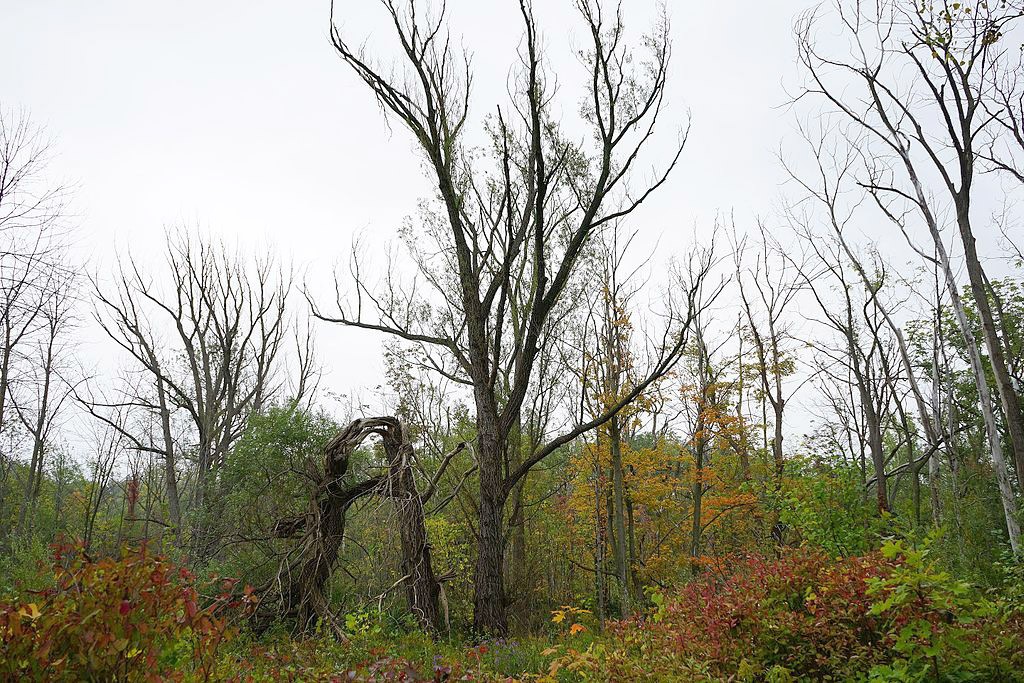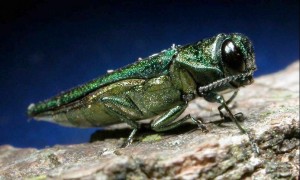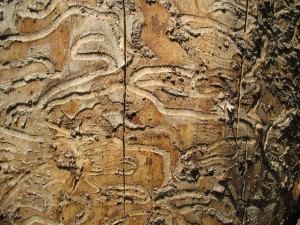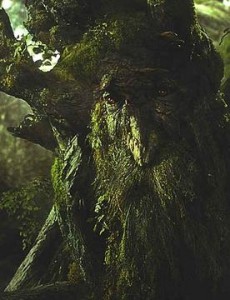Invasive borer quickly turns ash trees into widowmakers

Ash borer damage in the Red Hill Valley near Hamilton, Ontario. Photo: Michael Hunter, Creative Commons, some rights reserved
Call it an infection or an epidemic, but even the most docile and pleasant woods will soon be transformed into Fangorn Forest. As far as anyone knows, local trees will probably not become animate like the ones in the fictional woodland of J.R.R. Tolkein’s trilogy. However, they may be just as dangerous, only for a different reason.
In The Lord of the Rings, trees were inherently good, and if provoked sufficiently could take up arms and kill lots of bad guys. Presumably our trees are also of good will, or at least do not have anything against humans in particular. But changes are coming within the next decade that will render them dangerous through no fault or intent of their own.

The invasive emerald ash borer has all but wiped out ash trees wherever it has become established. Photo: USDA.
Farmers, camp owners, woodlot owners, and anyone who cuts their own firewood will be affected by this turn of events. By now we have all heard that the emerald ash borer (EAB) has been confirmed in the Town of Hammond in St. Lawrence County, as well as in Franklin County, not far from Massena. And also by now we may be tired of hearing about this invasive wood-boring beetle and how it will wipe out all species of ash trees. Chestnuts and elms died out and the world didn’t end, so why all the fuss about EAB?
Most of the time, when a healthy tree is killed by a pest, disease or flood, it stands there and waits 5 or 10 or 15 years for you to cut it for firewood. If you don’t show up, it shrugs, mumbles something about your lack of work ethic, and topples over. Think of all the dead trees in beaver ponds that stand for a decade or more as herons nest in their bleached crowns. After the chestnut blight wiped out that species, there were reports of the dead snags remaining upright for 30 or more years.
But the emerald ash borer has a peculiar effect on the ash trees it kills. Ash that succumb to EAB become dangerous in as little as one year, and after only two years, they start leaping onto cars, trucks and busloads of schoolkids. OK, that is taking it a little too far, but many people have been injured, and many homes and vehicles damaged in the wake of EAB infestations. In Ohio, a school bus was hit by a large dead (EAB-killed) ash tree, injuring 5 students and the driver, and pretty well totaling the bus.

Emerald Ash Borer damage up close. Photo: John Hritz, Creative Commons, some rights reserved
No one seems to have an adequate explanation for this rapid and profound loss of wood strength, but I’ll pass along what we do know. According to the Davey Resource Group, the consulting and research branch of Davey Tree, the shear strength of ash wood undergoes a five-fold decrease after the tree is infested by EAB. Trees become dangerous so quickly that Davey Tree will not allow its climbers into any infested ash that shows a 20% decline or more.
In the words of Mike Chenail, an International Society of Arboriculture Certified Arborist from Pennsylvania, “Two realities make an ash tree killed by EAB especially dangerous. EAB cuts off the flow of water and nutrients through the tree. Additionally, the fatal pest creates thousands of exit wounds. Both conspire to dry out the tree and make it brittle.”
Dr. John Ball of South Dakota State University quantifies the moisture loss, saying “Moisture goes from 80% on a recently infested tree to less than 40% standing dead…There is also some drying of localized sapwood.” Sapwood is the outermost layer of wood, often just a few inches thick, so having it suddenly dry out may not seem like much. Jerry Bond, a Consulting Urban Forester with the Davey Resource Group, and a former Cornell Extension Educator, explained it to me this way: “Ninety percent of the structural strength of a tree resides in the outermost ten percent of the trunk.” In other words, when sapwood is weakened, there’s not much strength left in the tree. There may be yet another facet to the picture. Anecdotes from arborists and other tree workers point to the surprisingly advanced decay in some ash wood that had only been infested one season. How widespread or significant this may be is not yet known.

It could be scarier. Treebeard the Ent stalks Fangorn Forest.
But none of that is really the point. The point is that those who work in the woods, or spend any amount of time there, need to be aware that when EAB kills ash trees, they act differently. Think of it like a zombie infection. Wait, no, don’t. Just look out for trees behaving strangely, and remember it is nothing personal.
Woodlot owners, farmers, and others who want to learn best management practices for their property may want to attend an upcoming EAB informational session with foresters from the NYS Department of Environmental Conservation, and NYS Ag and Markets representatives. The meeting will take place from 5:45 to 8 PM on Wednesday November 1 at the Cornell Cooperative Extension Learning Farm in Canton. The session is free and open to the public, but pre-registration is requested. To register, or for more information, call Paul Hetzler at (315) 379-9192 ext. 232, or email [email protected].
Paul Hetzler is a horticulture and natural resources educator with Cornell Cooperative Extension of St. Lawrence County.
Tags: ash tree, emerald ash borer, forestry, public safety







